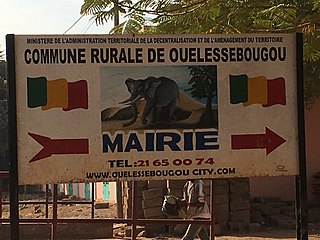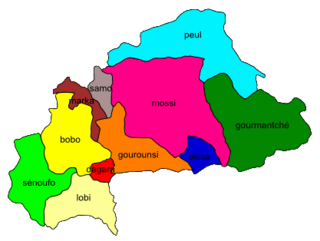Demographics
The Bobo number about 110,000 people, with the great majority in Burkina Faso. The major Bobo community in the south is Bobo-Dioulasso, the second-largest city of Burkina Faso and the old French colonial capital. Further north are large towns, including Fô [ fr ] and Kouka, with Boura in the extreme north in Mali.
The Bobo are the descendants of an ancient aggregation who assembled around a number of core clans, none which preserved any oral traditions of immigration into the area. The Bobo language and culture are more closely related to those of their Mandé neighbours to the north and west, the Bamana (as well as the Minianka, also known as Mamara Senoufo, and a Gur people) than to their Voltaic neighbours the Gurunsi and Mossi, but they should be thought of as a southern extension of the Mandé people who live in what is now Burkina Faso, rather than an intrusive Mandé group that has recently penetrated the region. Although over 41% of Bobo lineages claim a foreign origin, they also say that they are autochthonous.

Burkina Faso's 22.1 million people belong to two major West African cultural groups: the Gur (Voltaic) and the Mandé. The Voltaic are far more numerous and include the Mossi, who make up about one-half of the population. The Mossi claim descent from warriors who migrated to present-day Burkina Faso and established an empire that lasted more than 800 years. Predominantly farmers, the Mossi are still bound by the traditions of the Mogho Naba, who hold court in Ouagadougou.

Dyula is a language of the Mande language family spoken mainly in Burkina Faso, Ivory Coast and Mali, and also in some other countries, including Ghana, Guinea and Guinea-Bissau. It is one of the Manding languages and is most closely related to Bambara, being mutually intelligible with Bambara as well as Malinke. It is a trade language in West Africa and is spoken by millions of people, either as a first or second language. Similar to the other Mande languages, it uses tones. It may be written in the Latin, Arabic or N'Ko scripts.

The balafon is a gourd-resonated xylophone, a type of struck idiophone. It is closely associated with the neighbouring Mandé, Bwaba Bobo, Senoufo and Gur peoples of West Africa, particularly the Guinean branch of the Mandinka ethnic group, but is now found across West Africa from Guinea, Burkina Faso, Mali. Its common name, balafon, is likely a European coinage combining its Mandinka name ߓߟߊ bala with the word ߝߐ߲ fôn 'to speak' or the Greek root phono.

The music of Burkina Faso includes the folk music of 60 different ethnic groups. The Mossi people, centrally located around the capital, Ouagadougou, account for 40% of the population while, to the south, Gurunsi, Gurma, Dagaaba and Lobi populations, speaking Gur languages closely related to the Mossi language, extend into the coastal states. In the north and east the Fulani of the Sahel preponderate, while in the south and west the Mande languages are common; Samo, Bissa, Bobo, Senufo and Marka. Burkinabé traditional music has continued to thrive and musical output remains quite diverse. Popular music is mostly in French: Burkina Faso has yet to produce a major pan-African success.

Bobo-Dioulasso is a city in Burkina Faso with a population of 1,129,000 ; it is the second-largest city in the country, after Ouagadougou, Burkina Faso's capital. The name means "home of the Bobo-Dioula".

Mali is a multilingual country of about 21.9 million people. The languages spoken there reflect ancient settlement patterns, migrations, and its long history. Ethnologue counts more than 80 languages. Of these, Bambara, Bobo, Bozo, Dogon, Fula, Arabic, Kassonke, Maninke, Minyanka, Senufo, Songhay languages, Soninke and Tamasheq are official languages.
The Mandé peoples are a linguistic grouping of those African nations who speak Mande languages. They are not a coherent ethnic or cultural group. The various Mandé-speaking nations are concentrated in the western regions of West Africa.

The Kénédougou Kingdom,, was a pre-colonial West African state established in the southeastern portion of present-day Mali, as well as parts of northern Côte d'Ivoire and western Burkina Faso.
Articles related to Burkina Faso include:
The Bwa is an African society that is native to Burkina Faso. This society has an approximate population of over 300,000 persons. The Bwa people live in a number of individualized communities. They have no central government, and rely on their community standards. They are most known for their scarification and elaborate plank masks.

Burkina Faso is a multilingual country. An estimated 70 languages are spoken there, of which about 66 are indigenous. Mooré is spoken by about 52.5% of the population, mainly in the central region around the capital, Ouagadougou.
Mafoune is a small town and commune in the Cercle of Tominian in the Ségou Region of Mali. As of 1998 the commune had a population of 16,141. It lies near the border with Burkina Faso.The main ethnical groups of the Mafoune commune: Bwa, Fulani, Minianka, Dogon, Bambara... Some villages of the commune are: Mafoune, Sira, Kira, Wanian, Zogoue, Wara, Lohan, Lakuy, Makoina, Lebekuy, Panani, Bourelo,Bokuy (Mankoina),Bokuy (Lohan),Mandoulo,Kian,Mouni...
Viemo, also known as Vige, Vigué, Vigye, is a language of Burkina Faso. Vigué is the term for the ethniciity while Viemo is the name of the language. It may be related at a higher level to the Gur language family, but its exact affiliation within Niger–Congo languages is not yet established. It is spoken in Karangasso-Vigué Department and in neighbouring provinces.

The Bobo language is a Mande language of Burkina Faso and Mali; the western city of Bobo Dioulasso is named partly for the Bobo people. It consists of Southern and Northern dialect. The Northern dialect is also known as Konabéré. Northern and Southern Bobo share only 20%–30% intelligibility according to Ethnologue, and by that standard are considered separate languages.
The Bwa languages are a branch of the Gur languages spoken by over half a million Bwa people of Burkina Faso and Mali.
The Bo language of West Africa, Bomu (Boomu), also identified as Western Bobo Wule, is a Gur language of Burkina Faso and Mali.

The art of Burkina Faso is the product of a rich cultural history. In part, this is because so few people from Burkina have become Muslim or Christian. Many of the ancient artistic traditions for which Africa is so well known have been preserved in Burkina Faso because so many people continue to honor the ancestral spirits, and the spirits of nature. In great part they honor the spirits through the use of masks and carved figures. Many of the countries to the north of Burkina Faso had become predominantly Muslim, while many of the countries to the south of Burkina Faso are heavily Christian. In contrast many of the people of Burkina Faso continue to offer prayers and sacrifices to the spirits of nature and to the spirits of their ancestors. The result is that they continue to use the sorts of art that we see in museums in Europe and America.
Victor Démé was a Burkinabé musician and singer-songwriter originating from a Mandinka family. His death was caused by a bout of malaria.











